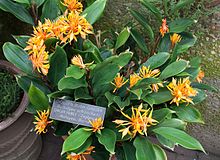
Convolvulaceae, commonly called the bindweeds or morning glories, is a family of about 60 genera and more than 1,650 species. These species are primarily herbaceous vines, but also include trees, shrubs and herbs. The tubers of several species are edible, the best known of which is the sweet potato.

The Scrophulariaceae are a family of flowering plants, commonly known as the figwort family. The plants are annual and perennial herbs, as well as shrubs. Flowers have bilateral (zygomorphic) or rarely radial (actinomorphic) symmetry. The Scrophulariaceae have a cosmopolitan distribution, with the majority found in temperate areas, including tropical mountains. The family name is based on the name of the included genus Scrophularia L.

Plantaginaceae, the plantain family, is a large, diverse family of flowering plants in the order Lamiales that includes common flowers such as snapdragon and foxglove. It is unrelated to the banana-like fruit also called "plantain." In older classifications, Plantaginaceae was the only family of the order Plantaginales, but numerous phylogenetic studies, summarized by the Angiosperm Phylogeny Group, have demonstrated that this taxon should be included within Lamiales.
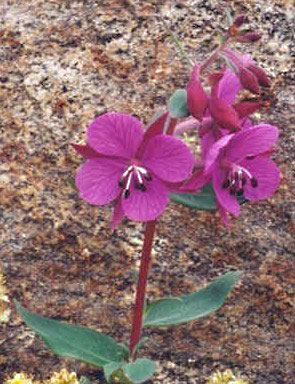
The Onagraceae are a family of flowering plants known as the willowherb family or evening primrose family. They include about 650 species of herbs, shrubs, and trees in 17 genera. The family is widespread, occurring on every continent from boreal to tropical regions.
Tropane is a nitrogenous bicyclic organic compound. It is mainly known for the other alkaloids derived from it, which include atropine and cocaine, among others. Tropane alkaloids occur in plants of the families Erythroxylaceae and Solanaceae.
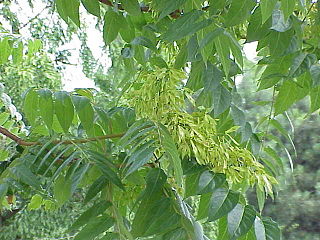
The Simaroubaceae are a small, mostly tropical, family in the order Sapindales. In recent decades, it has been subject to much taxonomic debate, with several small families being split off. A molecular phylogeny of the family was published in 2007, greatly clarifying relationships within the family. Together with chemical characteristics such as the occurrence of petroselinic acid in Picrasma, in contrast to other members of the family such as Ailanthus, this indicates the existence of a subgroup in the family with Picrasma, Holacantha, and Castela.

Nyctaginaceae, the four o'clock family, is a family of around 33 genera and 290 species of flowering plants, widely distributed in tropical and subtropical regions, with a few representatives in temperate regions. The family has a unique fruit type, called an "anthocarp", and many genera have extremely large pollen grains.
Germplasm Resources Information Network or GRIN is an online USDA National Genetic Resources Program software project to comprehensively manage the computer database for the holdings of all plant germplasm collected by the National Plant Germplasm System.
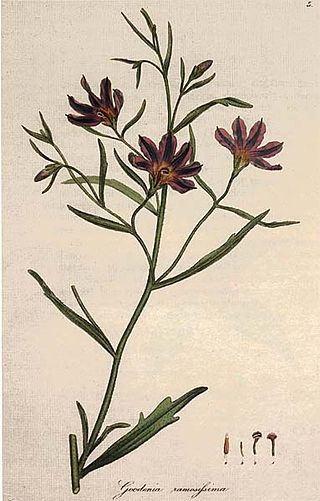
Goodeniaceae is a family of flowering plants in the order Asterales. It contains about 404 species in twelve genera. The family is distributed mostly in Australia, except for the genus Scaevola, which is pantropical. Its species are found across most of Australia, being especially common in arid and semi-arid climates.

Apocynoideae is a subfamily of the flowering plant family Apocynaceae. It contains about 78 genera with roughly 860 species. Several genera are of pharmacological interest - notably those - such as Strophanthus - which have furnished highly effective arrow poisons, due to their cardiac glycoside content. The subfamily includes many species with flowers of considerable ornamental value, the best-known of which is Nerium oleander, the familiar Oleander. It also contains the remarkable pachycaul genera Adenium and Pachypodium.

Phyllonoma is a genus consisting of 4 species of trees and shrubs. Phyllonoma is the sole genus in the family Phyllonomaceae. Phyllonoma species are native to South and Central America.

Cordyla is a genus of flowering plants in the family Fabaceae. It contains the following species:

Uvaria is a genus of flowering plants in the family Annonaceae. The generic name uvaria is derived from the Latin uva meaning grape, likely because the edible fruit of some species in the genus resemble grapes.

Tetrachondraceae is a plant family in the order Lamiales. The family contains the two genera Polypremum and Tetrachondra, which together comprise the three species:

Ajugoideae is subfamily of the family Lamiaceae. The subfamily name of Teucrioideae is a synonym of Ajugoideae.

The 'Julie' mango, also called 'Saint Julian', is a named mango cultivar that was made popular in the Caribbean.
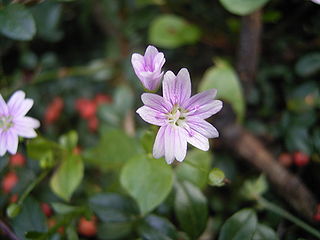
Montiaceae are a family of flowering plants, comprising about 14 genera with about 230 known species, ranging from small herbaceous plants to shrubs. The family has a cosmopolitan distribution.
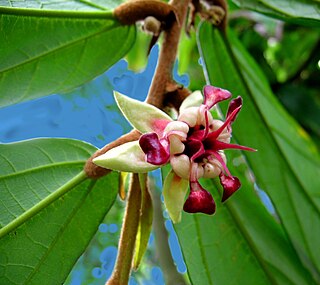
Byttnerioideae is a subfamily of the flowering plant family Malvaceae.
MusaNet is a global network of scientists and other stakeholders working on banana genetic resources. Founded in 2011 and coordinated by Bioversity International, it has over 100 individual members representing various banana research institutes and organizations.

